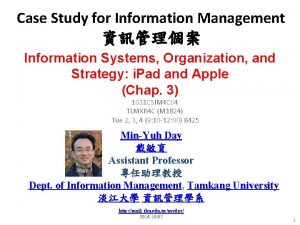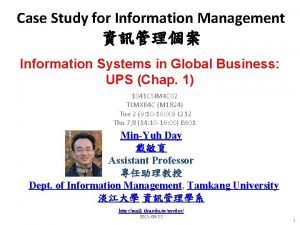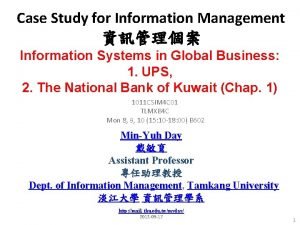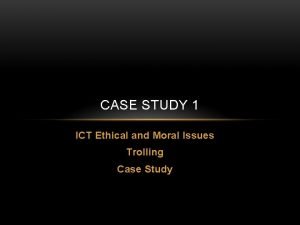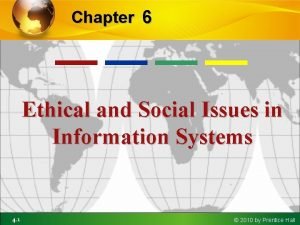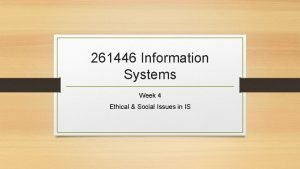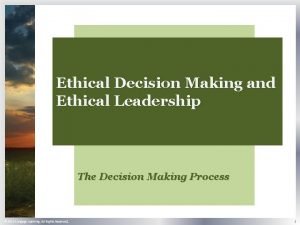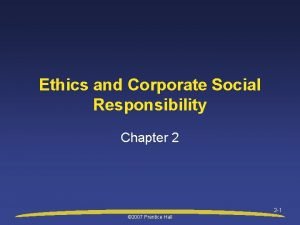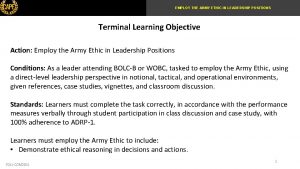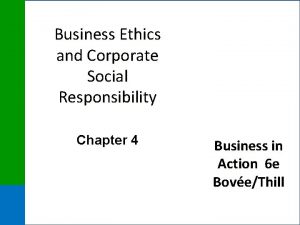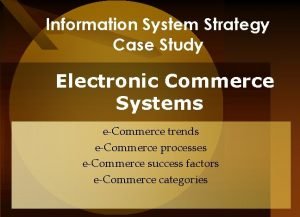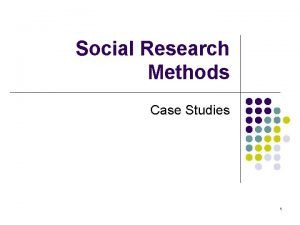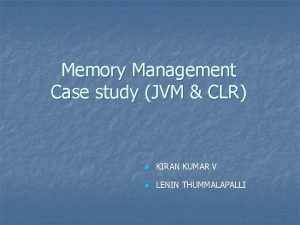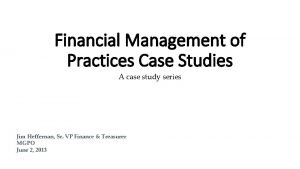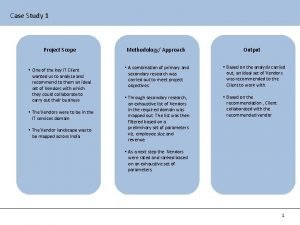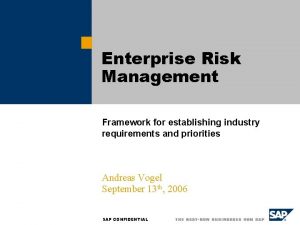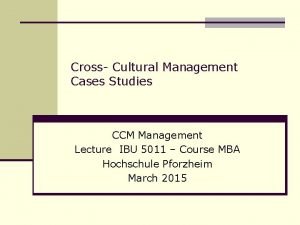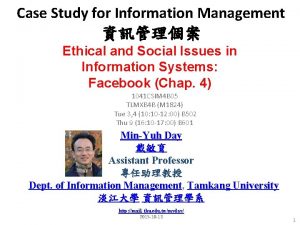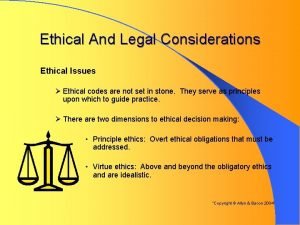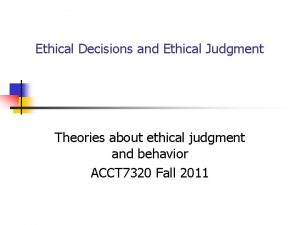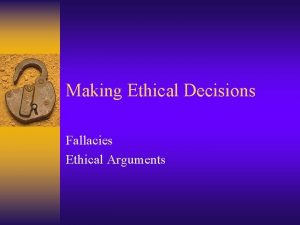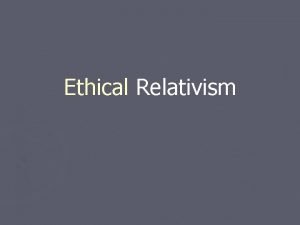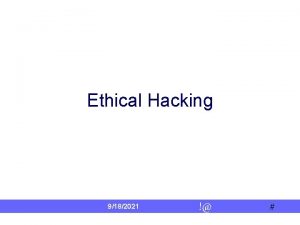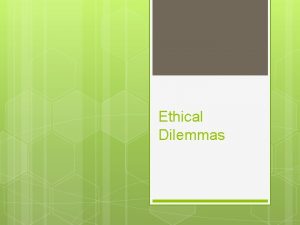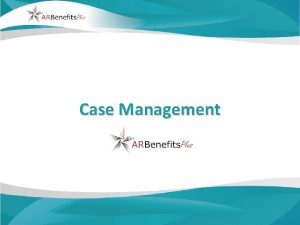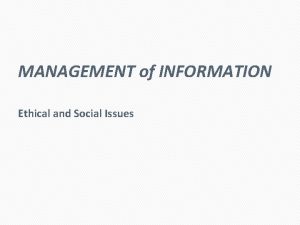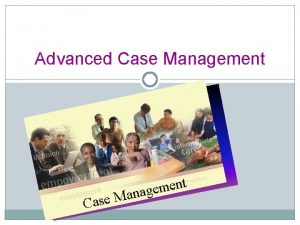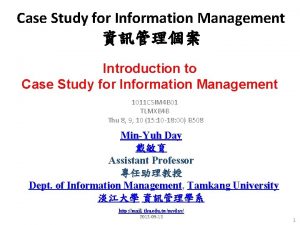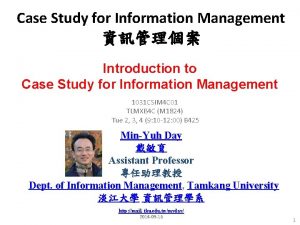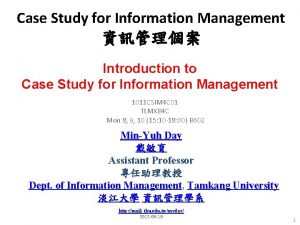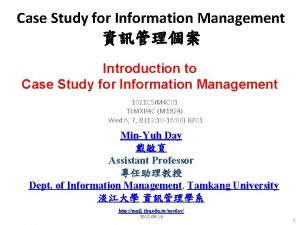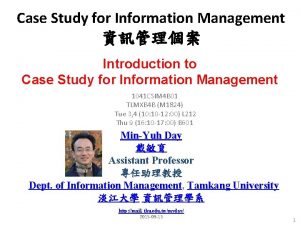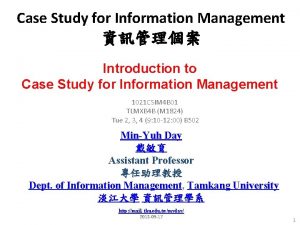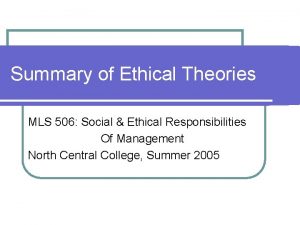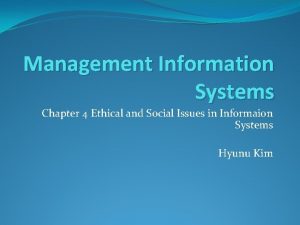Case Study for Information Management Ethical and Social


































- Slides: 34

Case Study for Information Management 資訊管理個案 Ethical and Social Issues in Information Systems: Facebook (Chap. 4) 1041 CSIM 4 C 05 TLMXB 4 C (M 1824) Tue 2 (9: 10 -10: 00) B 502 Thu 7, 8 (14: 10 -16: 00) B 601 Min-Yuh Day 戴敏育 Assistant Professor 專任助理教授 Dept. of Information Management, Tamkang University 淡江大學 資訊管理學系 http: //mail. tku. edu. tw/myday/ 2015 -10 -13 1

課程大綱 (Syllabus) 週次 (Week) 日期 (Date) 內容 (Subject/Topics) 1 2015/09/15, 17 Introduction to Case Study for Information Management 2 2015/09/22, 24 Information Systems in Global Business: UPS (Chap. 1) (pp. 53 -54) 3 2015/09/29, 10/01 Global E-Business and Collaboration: P&G (Chap. 2) (pp. 84 -85) 4 2015/10/06, 08 Information Systems, Organization, and Strategy: Starbucks (Chap. 3) (pp. 129 -130) 5 2015/10/13, 15 Ethical and Social Issues in Information Systems: Facebook (Chap. 4) (pp. 188 -190) 2

課程大綱 (Syllabus) 週次 (Week) 日期 (Date) 內容 (Subject/Topics) 6 2015/10/20, 22 IT Infrastructure and Emerging Technologies: Amazon and Cloud Computing (Chap. 5) (pp. 234 -236) 7 2015/10/27, 29 Foundations of Business Intelligence: IBM and Big Data (Chap. 6) (pp. 261 -262) 8 2015/11/03, 05 Telecommunications, the Internet, and Wireless Technology: Google, Apple, and Microsoft (Chap. 7) (pp. 318 -320) 9 2015/11/10, 12 Midterm Report (期中報告) 10 2015/11/17, 19 期中考試週 3

課程大綱 (Syllabus) 週次 日期 內容(Subject/Topics) 11 2015/11/24, 26 Enterprise Applications: Summit and SAP (Chap. 9) (pp. 396 -398) 12 2015/12/01, 03 E-commerce: Zagat (Chap. 10) (pp. 443 -445) 13 2015/12/08, 10 Enhancing Decision Making: Zynga (Chap. 12) (pp. 512 -514) 14 2015/12/15, 17 Building Information Systems: USAA (Chap. 13) (pp. 547 -548) 15 2015/12/22, 24 Managing Projects: NYCAPS and City. Time (Chap. 14) (pp. 586 -588) 16 2015/12/29, 31 Final Report I (期末報告 I) 17 2016/01/05, 07 Final Report II (期末報告 II) 18 2016/01/12, 14 期末考試週 4

Chap. 4 Ethical and Social Issues in Information Systems: Facebook 5

Case Study: Facebook (Chap. 4) (pp. 188 -190) Facebook: It’s about the Money 1. Perform an ethical analysis of Facebook. What is the ethical dilemma presented by this case? 2. What is the relationship of privacy to Facebook’s business model? 3. Describe the weaknesses of Facebook’s privacy policies and features. What management, organization, and technology factors have contributed to those weaknesses? 4. Will Facebook be able to have a successful business model without invading privacy? Explain your answer. Are there any measures Facebook could take to make this possible? Source: Kenneth C. Laudon & Jane P. Laudon (2014), Management Information Systems: Managing the Digital Firm, Thirteenth Edition, Pearson. 6

Overview of Fundamental MIS Concepts Business Challenges Management Organization Information System Business Solutions Technology Source: Kenneth C. Laudon & Jane P. Laudon (2014), Management Information Systems: Managing the Digital Firm, Thirteenth Edition, Pearson. 7

Information Systems and Ethics • Information systems raise new ethical questions because they create opportunities for: – Intense social change, threatening existing distributions of power, money, rights, and obligations – New kinds of crime Source: Kenneth C. Laudon & Jane P. Laudon (2014), Management Information Systems: Managing the Digital Firm, Thirteenth Edition, Pearson. 8

THE RELATIONSHIP AMONG ETHICAL, SOCIAL, POLITICAL ISSUES IN AN INFORMATION SOCIETY Source: Kenneth C. Laudon & Jane P. Laudon (2014), Management Information Systems: Managing the Digital Firm, Thirteenth Edition, Pearson. 9

A model for thinking about ethical, social, and political Issues • Society as a calm pond • IT as rock dropped in pond, creating ripples of new situations not covered by old rules • Social and political institutions cannot respond overnight to these ripples—it may take years to develop etiquette, expectations, laws – Requires understanding of ethics to make choices in legally gray areas Source: Kenneth C. Laudon & Jane P. Laudon (2014), Management Information Systems: Managing the Digital Firm, Thirteenth Edition, Pearson. 10

Five moral dimensions of the information age 1. 2. 3. 4. 5. Information rights and obligations Property rights and obligations Accountability and control System quality Quality of life Source: Kenneth C. Laudon & Jane P. Laudon (2014), Management Information Systems: Managing the Digital Firm, Thirteenth Edition, Pearson. 11

Key technology trends that raise ethical issues 1. Doubling of computer power – More organizations depend on computer systems for critical operations. 2. Rapidly declining data storage costs – Organizations can easily maintain detailed databases on individuals. 3. Networking advances and the Internet – Copying data from one location to another and accessing personal data from remote locations are much easier. Source: Kenneth C. Laudon & Jane P. Laudon (2014), Management Information Systems: Managing the Digital Firm, Thirteenth Edition, Pearson. 12

Key technology trends that raise ethical issues 4. Advances in data analysis techniques – Profiling • Combining data from multiple sources to create dossiers of detailed information on individuals – Nonobvious relationship awareness (NORA) • Combining data from multiple sources to find obscure hidden connections that might help identify criminals or terrorists 5. Mobile device growth – Tracking of individual cell phones Source: Kenneth C. Laudon & Jane P. Laudon (2014), Management Information Systems: Managing the Digital Firm, Thirteenth Edition, Pearson. 13

NONOBVIOUS RELATIONSHIP AWARENESS (NORA) Source: Kenneth C. Laudon & Jane P. Laudon (2014), Management Information Systems: Managing the Digital Firm, Thirteenth Edition, Pearson. 14

Basic concepts for ethical analysis • Responsibility: – Accepting the potential costs, duties, and obligations for decisions • Accountability: – Mechanisms for identifying responsible parties • Liability: – Permits individuals (and firms) to recover damages done to them • Due process: – Laws are well-known and understood, with an ability to appeal to higher authorities Source: Kenneth C. Laudon & Jane P. Laudon (2014), Management Information Systems: Managing the Digital Firm, Thirteenth Edition, Pearson. 15

Five-step ethical analysis 1. Identify and clearly describe the facts. 2. Define the conflict or dilemma and identify the higher-order values involved. 3. Identify the stakeholders. 4. Identify the options that you can reasonably take. 5. Identify the potential consequences of your options. Source: Kenneth C. Laudon & Jane P. Laudon (2014), Management Information Systems: Managing the Digital Firm, Thirteenth Edition, Pearson. 16

Information rights: privacy and freedom in the Internet age • Privacy: – Claim of individuals to be left alone, free from surveillance or interference from other individuals, organizations, or state; claim to be able to control information about yourself • In the United States, privacy protected by: – First Amendment (freedom of speech) – Fourth Amendment (unreasonable search and seizure) – Additional federal statues (e. g. , Privacy Act of 1974) Source: Kenneth C. Laudon & Jane P. Laudon (2014), Management Information Systems: Managing the Digital Firm, Thirteenth Edition, Pearson. 17

Fair Information Practices (FIP) • Set of principles governing the collection and use of information – Basis of most U. S. and European privacy laws – Based on mutuality of interest between record holder and individual – Restated and extended by FTC in 1998 to provide guidelines for protecting online privacy • Used to drive changes in privacy legislation – COPPA – Gramm-Leach-Bliley Act – HIPAA – Do-Not-Track Online Act of 2011 Source: Kenneth C. Laudon & Jane P. Laudon (2014), Management Information Systems: Managing the Digital Firm, Thirteenth Edition, Pearson. 18

Federal Trade Commission (FTC) Fair Information Practices (FIP) principles 1. Notice/awareness (core principle) – Web sites must disclose practices before collecting data. 2. Choice/consent (core principle) – Consumers must be able to choose how information is used for secondary purposes. 3. Access/participation – Consumers must be able to review and contest accuracy of personal data. Source: Kenneth C. Laudon & Jane P. Laudon (2014), Management Information Systems: Managing the Digital Firm, Thirteenth Edition, Pearson. 19

Federal Trade Commission (FTC) Fair Information Practices (FIP) principles 4. Security – Data collectors must take steps to ensure accuracy, security of personal data. 5. Enforcement – Must be mechanism to enforce FIP principles. Source: Kenneth C. Laudon & Jane P. Laudon (2014), Management Information Systems: Managing the Digital Firm, Thirteenth Edition, Pearson. 20

Internet challenges to privacy • Cookies – Identify browser and track visits to site – Super cookies (Flash cookies) • Web beacons (Web bugs) – Tiny graphics embedded in e-mails and Web pages – Monitor who is reading e-mail message or visiting site • Spyware – Surreptitiously installed on user’s computer – May transmit user’s keystrokes or display unwanted ads • Google services and behavioral targeting Source: Kenneth C. Laudon & Jane P. Laudon (2014), Management Information Systems: Managing the Digital Firm, Thirteenth Edition, Pearson. 21

HOW COOKIES IDENTIFY WEB VISITORS Source: Kenneth C. Laudon & Jane P. Laudon (2014), Management Information Systems: Managing the Digital Firm, Thirteenth Edition, Pearson. 22

Internet challenges to privacy • The United States allows businesses to gather transaction information and use this for other marketing purposes. – Opt-out vs. opt-in model • Online industry promotes self-regulation over privacy legislation. • However, extent of responsibility taken varies: – Complex/ambiguous privacy statements – Opt-out models selected over opt-in – Online “seals” of privacy principles Source: Kenneth C. Laudon & Jane P. Laudon (2014), Management Information Systems: Managing the Digital Firm, Thirteenth Edition, Pearson. 23

Technical solutions for privacy • • E-mail encryption Anonymity tools Anti-spyware tools Browser features – “Private” browsing – “Do not track” options • Overall, few technical solutions Source: Kenneth C. Laudon & Jane P. Laudon (2014), Management Information Systems: Managing the Digital Firm, Thirteenth Edition, Pearson. 24

Property rights: Intellectual property • Intellectual property: intangible property of any kind created by individuals or corporations • Three main ways that intellectual property is protected: – Trade secret: intellectual work or product belonging to business, not in the public domain – Copyright: statutory grant protecting intellectual property from being copied for the life of the author, plus 70 years – Patents: grants creator of invention an exclusive monopoly on ideas behind invention for 20 years Source: Kenneth C. Laudon & Jane P. Laudon (2014), Management Information Systems: Managing the Digital Firm, Thirteenth Edition, Pearson. 25

Challenges to intellectual property rights • Digital media different from physical media (e. g. , books) – Ease of replication – Ease of transmission (networks, Internet) – Difficulty in classifying software – Compactness – Difficulties in establishing uniqueness • Digital Millennium Copyright Act (DMCA) – Makes it illegal to circumvent technology-based protections of copyrighted materials Source: Kenneth C. Laudon & Jane P. Laudon (2014), Management Information Systems: Managing the Digital Firm, Thirteenth Edition, Pearson. 26

Accountability, liability, control • Computer-related liability problems – If software fails, who is responsible? • If seen as part of machine that injures or harms, software producer and operator may be liable. • If seen as similar to book, difficult to hold author/publisher responsible. • What should liability be if software seen as service? Would this be similar to telephone systems not being liable for transmitted messages? Source: Kenneth C. Laudon & Jane P. Laudon (2014), Management Information Systems: Managing the Digital Firm, Thirteenth Edition, Pearson. 27

System quality: Data quality and system errors • What is an acceptable, technologically feasible level of system quality? – Flawless software is economically unfeasible. • Three principal sources of poor system performance: – Software bugs, errors – Hardware or facility failures – Poor input data quality (most common source of business system failure) Source: Kenneth C. Laudon & Jane P. Laudon (2014), Management Information Systems: Managing the Digital Firm, Thirteenth Edition, Pearson. 28

Quality of life: Equity, access, boundaries • Negative social consequences of systems – Balancing power: although computing power decentralizing, key decision making remains centralized – Rapidity of change: businesses may not have enough time to respond to global competition – Maintaining boundaries: computing, Internet use lengthens work-day, infringes on family, personal time – Dependence and vulnerability: public and private organizations ever more dependent on computer systems Source: Kenneth C. Laudon & Jane P. Laudon (2014), Management Information Systems: Managing the Digital Firm, Thirteenth Edition, Pearson. 29

Quality of life: Equity, access, boundaries • Computer crime and abuse – Computer crime: commission of illegal acts through use of computer or against a computer system—computer may be object or instrument of crime – Computer abuse: unethical acts, not illegal • Spam: high costs for businesses in dealing with spam • Employment: – Reengineering work resulting in lost jobs • Equity and access—the digital divide: – Certain ethnic and income groups in the United States less likely to have computers or Internet access Source: Kenneth C. Laudon & Jane P. Laudon (2014), Management Information Systems: Managing the Digital Firm, Thirteenth Edition, Pearson. 30

Quality of life: Equity, access, boundaries • Health risks – Repetitive stress injury (RSI) • Largest source is computer keyboards • Carpal tunnel syndrome (CTS) – Computer vision syndrome (CVS) • Eyestrain and headaches related to screen use – Technostress • Aggravation, impatience, fatigue Source: Kenneth C. Laudon & Jane P. Laudon (2014), Management Information Systems: Managing the Digital Firm, Thirteenth Edition, Pearson. 31

Case Study: Amazon and Cloud Computing (Chap. 5) (pp. 234 -236) Should Businesses Move to the Cloud? 1. What business benefits do cloud computing services provide? What problems do they solve? 2. What are the disadvantages of cloud computing? 3. How do the concepts of capacity planning, scalability, and TCO apply to this case? Apply these concepts both to Amazon and to subscribers of its services. 4. What kinds of businesses are most likely to benefit from using cloud computing? Why? Source: Kenneth C. Laudon & Jane P. Laudon (2014), Management Information Systems: Managing the Digital Firm, Thirteenth Edition, Pearson. 32


References – Kenneth C. Laudon & Jane P. Laudon (2014), Management Information Systems: Managing the Digital Firm, Thirteenth Edition, Pearson. – Kenneth C. Laudon & Jane P. Laudon原著, 游張松 主編,陳文生 翻譯 (2014), 資訊管理系統,第 13版,滄海 34
 Professional issues in information system
Professional issues in information system Management information system case study
Management information system case study Laudon and laudon 2012
Laudon and laudon 2012 Information system case study
Information system case study Management information system case study banking
Management information system case study banking Facebook ethical issues case study
Facebook ethical issues case study Daily activities work immersion
Daily activities work immersion Ethical and social issues in information system
Ethical and social issues in information system Chapter 4 ethical issues
Chapter 4 ethical issues 4 components of an information system
4 components of an information system Ethical and social issues in information systems
Ethical and social issues in information systems Sam and verna case study
Sam and verna case study The perceived relevance or importance of an ethical issue
The perceived relevance or importance of an ethical issue Best worst and average case
Best worst and average case Fbi virtual case file case study
Fbi virtual case file case study Perbedaan ethical dilemma dan ethical lapse
Perbedaan ethical dilemma dan ethical lapse Ethical lenses army
Ethical lenses army Perspectives of csr
Perspectives of csr Information system in e commerce case study
Information system in e commerce case study Risk management case study oil and gas industry
Risk management case study oil and gas industry The writer properly quotes and cited sources in some places
The writer properly quotes and cited sources in some places Legal ethical and societal issues in media and information
Legal ethical and societal issues in media and information Case study in social research
Case study in social research Swanage coastal management case study
Swanage coastal management case study Cargill performance management
Cargill performance management Mcdonald's case study strategic management pdf
Mcdonald's case study strategic management pdf Happisburgh case study
Happisburgh case study Apollo planogram software
Apollo planogram software Clr memory management
Clr memory management Walton on the naze coastal management case study
Walton on the naze coastal management case study Financial management case studies
Financial management case studies Project scope management case study
Project scope management case study Enterprise risk management at hydro one case study solution
Enterprise risk management at hydro one case study solution Zara strategic management
Zara strategic management Short case study on cross cultural management
Short case study on cross cultural management


